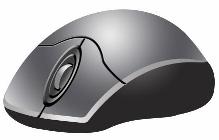What is a computer mouse?

A computer mouse is a small device that comes standard with most modern computers. It is a pointing device used to move a cursor around a computer screen. A mouse consists of a small case, held under one of the user’s hands, with one or more buttons placed on the top of the mouse that enables you to manipulate objects on the screen and make menu selections.
The mouse is a crucial element of the graphical user interface (GUI) systems. It was invented by Doug Engelbart and presented at the Fall Joint Computer Conference held in San Francisco in 1968. Complex mouse gestures have been developed by software designers and the mouse has been enhanced with additional buttons and wheels to suit users’ needs.
Mice connect to computers depending on the type of connector they need:
- Serial mice connect directly to an RS-232C serial port or a PS/2 port. This is the simplest type of connection. PS/2 mice connect to a PS/2 port. USB mice use one of the USB ports in your computer
- Cordless mice are not physically connected at all. They eliminate the cord and rely on infrared or radio waves to communicate with the computer.
There are three basic types of mice:
- mechanical: Has a rubber or metal ball on its underside that can roll in all directions. Mechanical sensors within the mouse detect the direction the ball is rolling and move the screen pointer accordingly.
- optomechanical: Same as a mechanical mouse, but uses optical sensors to detect the motion of the ball.
- optical: Uses a laser to detect the mouse’s movement. You must move the mouse along a special mat with a grid so that the optical mechanism has a frame of reference. Optical mice have no mechanical moving parts. They respond more quickly and precisely than mechanical and optomechanical mice, but they are also more expensive.
